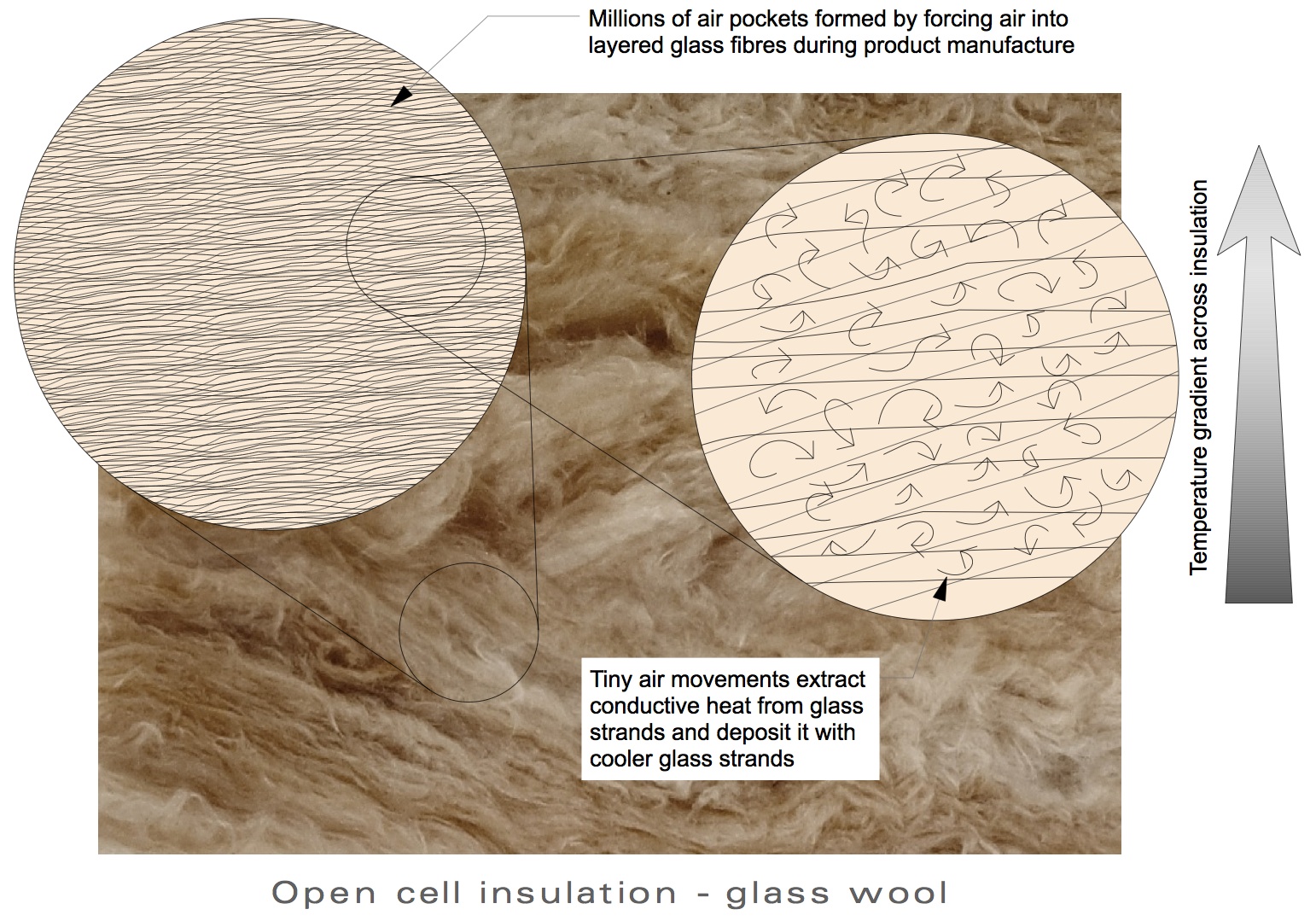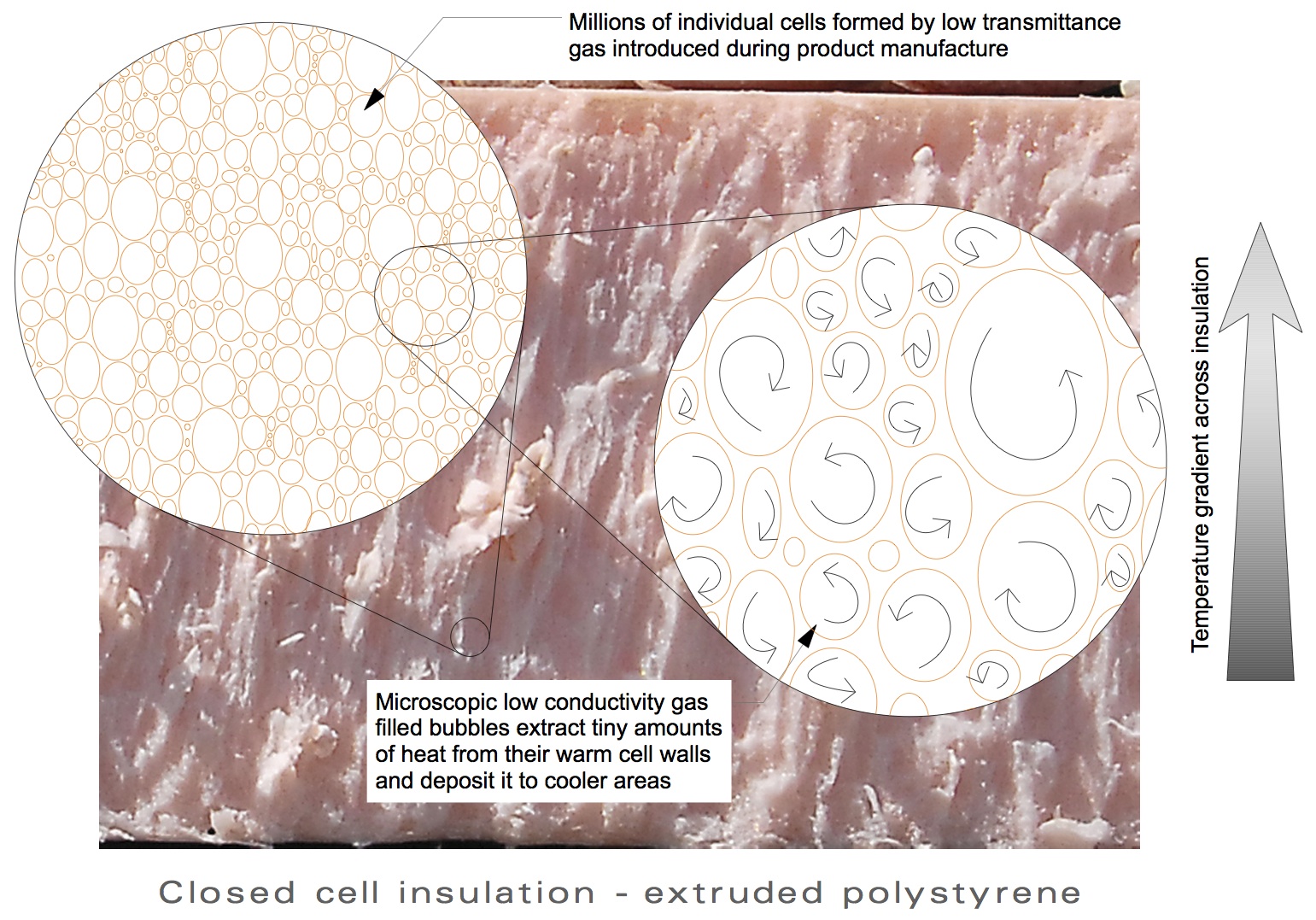Types of insulation
Contents |
[edit] Introduction
Thermal insulation materials have a low thermal conductivity which serves to limit the flow of heat energy between one side of the insulation and the other. In the build environment thermal insulation is typically used to reduce the passage of heat between the inside of a building and the outside.
For more information see: Thermal insulation.
There are many different types of insulation, which vary in terms of colour, surface finish texture, core composition and performance. Very broadly however, they tend to be open cell or closed cell.

|

|
| Open cell insulation | Closed cell insulation |
Open cell insulation allows the passage of air through air pockets, but the route is so complex that effectively, no air will pass from one side to the other, and so heat transfer by convection is prevented. Closed cell insulation is formed by bubbles of gas whose thermal conductivity is very low.
Some of the more common types are described below.
[edit] Blanket insulation (also called matting insulation)
This is generally the easiest to install and is commonly used as roof insulation. It typically comes in foil-backed rolls which can be placed between joists or rafters, and may be held in place by timber battens attached to and across the joists or rafters.
It is usually made of mineral or glass wool but can also be made from plastic fibres, and natural fibres such as cotton and sheep’s wool. The depth of blanket-style insulation varies depending on the exact composition and the performance required, but it is typically in the range of 100-200 mm.
[edit] Mineral wool
Mineral wool generally refers to fibre materials that are formed by spinning or drawing molten minerals. It can be manufactured in various thicknesses and widths and is often supplied in rolls.
[edit] Sheep’s wool
This type of insulation has the benefit of being 'sustainable', and offers an effective alternative to other synthetic types of insulation. It is increasingly being used between roof beams, under floors and in solid walls. It is often treated to make it more fire and insect resistant.
[edit] Glass wool
This type of insulating material consists of glass fibres arranged using a binder into a wool-like texture. Glass wool can be produced in a variety of ways, such as in rolls, slabs, applied in place, or sprayed.
[edit] Foam boards
These are rigid panels of insulation which are cut and fitted in place. Most commonly they are made from polystyrene, polyisocyanurate, and polyurethane, and may be fitted to a depth of around 175 mm. They are used predominantly where there is weight that needs support, i.e. under a floor or in a loft. The benefits of foam boards are that they are durable and can also provide acoustic insulation.
[edit] Radiant barriers
These inhibit heat transfer by thermal radiation. They are capable of being stapled to the underside of rafters. They are more effective in hot climates, where reduced heat gain may allow for smaller air conditioning systems. In cool climates, installing more thermal insulation it is usually more cost effective. The thickness of a radiant barrier is usually between 3-5 mm.
[edit] Blown-in insulation
This involves mineral fibres being blown into a void in the space that needs insulating. Although requiring specialist equipment, it is quick to install and can be effective for spaces with limited access, such as gaps between roof joists or cavity walls. The most common materials that are used include cellulose, fibre glass and mineral rock wool.
[edit] Spray foam insulation
Typically, spray foam is formed of polyurethane and is sprayed as a liquid which gradually expands to up to 100 times its original volume. Once set, it creates an effective thermal and noise insulating layer. Slow-curing foams can be used for cavity walls as they will flow around any obstructions before hardening. As spray foam can produce dangerous fumes and damage the structural integrity of the building if applied incorrectly, professional installation is recommended.
[edit] Structural insulated panels (SIPs)
Structural insulated panels (SIPs) are a form of composite sandwich panel system that incorporates insulation, predominantly used for residential and light commercial construction. They take the form of an insulating core (such as closed-cell polyurethane foam or expanded polystyrene) sandwiched between two structural facings.
The benefits of using SIPs are that they are high-strength, provide good thermal performance and can be fabricated to fit nearly any building design.
For more information, see Structural insulated panels.
[edit] Aerogel insulation
Aerogels are synthetic low-density materials with unique physical properties. Due to their high porosity, aerogels exhibit the lowest thermal conductivity of any solid, whilst being transparent to light and solar radiation. Aerogels are often cited as a promising material for translucent insulation applications.
Commercial products for the building sector include:
- Cavity insulation.
- Glazing units and cladding systems containing granular aerogel.
- Translucent and opaque insulation boards, blankets and tensile roof membranes embedded with aerogel particles.
For more information, see Aerogel.
[edit] Other types of insulation
Insulation also has other uses in the construction industry:
- Acoustic insulation to prevent the transmission of sound. For more information see: Acoustic insulation.
- Fire insulation to prevent the passage of fire between spaces or components.
- Electrical insulation to contain and separate electrical conductors.
[edit] Related articles on Designing Buildings
- Aerogel insulation for buildings.
- BREEAM Insulation.
- Cavity wall insulation.
- Fire insulation.
- Floor insulation.
- Glass bottle floor foundation.
- Heat transfer.
- Icynene spray foam insulation
- Insulation.
- Insulating concrete form.
- Insulation for ground floors.
- Sarking.
- Sheathing.
- Solid wall insulation.
- Sound insulation.
- Structural insulated panels.
- Thermal insulation for buildings.
- Transparent insulation.
Featured articles and news
Social and affordable housing, a long term plan for delivery
The “Delivering a Decade of Renewal for Social and Affordable Housing” strategy sets out future path.
A change to adoptive architecture
Effects of global weather warming on architectural detailing, material choice and human interaction.
How big is the problem and what can we do to mitigate the effects?
Overheating guidance and tools for building designers
A number of cool guides to help with the heat.
The UK's Modern Industrial Strategy: A 10 year plan
Previous consultation criticism, current key elements and general support with some persisting reservations.
Building Safety Regulator reforms
New roles, new staff and a new fast track service pave the way for a single construction regulator.
Architectural Technologist CPDs and Communications
CIAT CPD… and how you can do it!
Cooling centres and cool spaces
Managing extreme heat in cities by directing the public to places for heat stress relief and water sources.
Winter gardens: A brief history and warm variations
Extending the season with glass in different forms and terms.
Restoring Great Yarmouth's Winter Gardens
Transforming one of the least sustainable constructions imaginable.
Construction Skills Mission Board launch sector drive
Newly formed government and industry collaboration set strategy for recruiting an additional 100,000 construction workers a year.
New Architects Code comes into effect in September 2025
ARB Architects Code of Conduct and Practice available with ongoing consultation regarding guidance.
Welsh Skills Body (Medr) launches ambitious plan
The new skills body brings together funding and regulation of tertiary education and research for the devolved nation.
Paul Gandy FCIOB announced as next CIOB President
Former Tilbury Douglas CEO takes helm.
UK Infrastructure: A 10 Year Strategy. In brief with reactions
With the National Infrastructure and Service Transformation Authority (NISTA).
Ebenezer Howard: inventor of the garden city. Book review.
Airtightness Topic Guide BSRIA TG 27/2025
Explaining the basics of airtightness, what it is, why it's important, when it's required and how it's carried out.























Comments